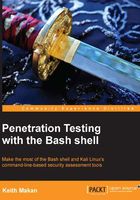
What this book covers
Chapter 1, Getting to Know Bash, introduces readers to the fundamental concepts involved in using the bash terminal. It covers utilities that readers will find helpful in their day-to-day activities as penetration testers, system administrators, and security-orientated developers.
Chapter 2, Customizing Your Shell, focuses on tips and tricks that readers can use to customize the behavior of the shells to suit their needs. It shows readers how to customize the cursor to format text, how to control command history securely, how to use aliases, and how to enable tab completion to make command-line utilities more user-friendly and easy to use.
Chapter 3, Network Reconnaissance, covers command-line utilities that readers can use to perform target enumeration and exfilterate information from common network services. This chapter introduces numerous tools, including Dnsmap, Nmap, and Whois among others, as well as useful ways to integrate these tools with the other command-line tools.
Chapter 4, Exploitation and Reverse Engineering, focuses on demonstrating and discussing the fundamental reverse engineering and host-based exploitation command-line driven tools. The chapter covers tools such as msfcli, msfpayload, GNU gdb, and various techniques, and shows how readers can combine these tools in useful ways with the help of bash scripting.
Chapter 5, Network Exploitation and Monitoring, shifts the focus to network exploitation tools and the utilities that the readers will likely use in their day-to-day penetration tests. The chapter covers tools such as ARPSpoof, Ettercap, and SSLyze, and also introduces readers to useful bash scripts and commands that optimize the usage of these commands and automates many common tasks.